When the time comes to feeding, young mother often falls into a stupor - where to start? What products will benefit the baby, and which can harm? Very often, the revelations of grandmothers or advanced mothers are shocking: “Ours at 5 months already had pickled cucumbers. So what if vinegar? They are homemade ... "
The opinion of pediatricians is such that supplements should be administered from 4 months for babies who are bottle feedingand from 6 months for babies to breastfeeding. However, it should be remembered that in this matter it is impossible to be categorical, because each baby is individual.
There are a number of signs to determine that the child is ready to expand his diet:
The appearance of the first teeth
Surely sitting on the highchair,
The interest in eating adults, trying to taste food,
Insufficient saturation of breast milk, a decrease in the time interval between feedings.
If these signs are present, the question immediately arises - how to start feeding? Eating a baby at 5 months should be nutritious, especially when there is a shortage of weight, as well as rich in vitamins and trace elements. You should start feeding with vegetable puree, if the child's weight is normal, or with cereal, if the weight does not reach the norm.
Squash,
Cauliflower,
Kashi should choose dairy-free, gluten-free.
It is still early to try meat and fish purees and broths at 5 months, since the baby’s intestines are not yet ready to digest heavy food.
Meals should take place at intervals of 4 hours, the baby should eat 5-6 times a day.
Sample menu for the day:
6: 00-7: 00 - breast milk or formula (180-200 g),
10:00-11:00 - vegetable puree (80-100 g),
14: 00-15: 00 - fruit puree (80-100 g), supplemented with breast milk or formula,
18: 00-19: 00 - some fruit juice (10-15 g), supplemented with breast milk or a mixture,
22: 00-23: 00 - breast milk or formula (180-200 g).
How to choose vegetable or fruit puree?
Shops offer the widest range of fruit, vegetable and berry puree. Manufacturers of a great variety, the price range is wide.
You can pick up any mashed potatoes to feed the child in 5 months and older. Contrary to skeptics, these purees are of high quality and absolutely safe for babies (of course, except for those cases when the child is allergic to a particular vegetable or fruit).
It is very convenient to use mashed potatoes in jars, it saves time and effort on preparing home-made mashed potatoes. But if you have time and desire to cook mashed potatoes for your baby by yourself - this is great!
In this case, the whole cooking process will be under the control of the mother - from the choice of vegetable or fruit to the placement of the finished mashed potatoes on the shelf of the refrigerator.
Zucchini Puree Recipe
Ingredients: zucchini - 1 pc.
You should choose young green zucchini no longer than 18-22 cm. Before buying carefully examine the vegetable - it should be fresh, without damage and rot. Also nearby on the counter should not be damaged copies.
Cooking:
Wash zucchini thoroughly with soap, cut the stem and the tip, peel. Cut into rings in 1-1.5 cm thick or cubes. Put in a saucepan, add water (about a third of the total volume of the pan), bring to a boil and simmer for no more than 15 minutes. The next step is turning a boiled zucchini into a puree using a blender. Ready mashed potatoes pass through a sieve - to remove large pieces. Transfer to a clean glass or ceramic container with a tight lid, cool. Before use, slightly warm, add a couple of drops of vegetable oil or a few grams breast milk. This puree can be stored in the refrigerator for 24 hours.
Broccoli puree recipeIngredients: Broccoli cabbage - 1 pc.
When choosing broccoli should pay attention to the head - it should smell fresh, the inflorescences are painted in a beautiful green color without yellowing, dark patches, damage and rot.
Cooking:
Thoroughly wash the head under a stream of water, disassemble into inflorescences and leave for 2 hours in a container with cold water - this will help get rid of dirt, insects, harmful substances. Broccoli can be steamed or boiled in lightly salted water. If there is a double boiler, some of the questions disappear, but if it is not there, it doesn't matter either. It is enough to place a colander or a sieve with inflorescences over boiling water so that the vegetable does not touch the water. Cooking time - 8-10 minutes. Grind the cooked steamed broccoli with a blender and rub through a sieve. Before use, you can add a little vegetable oil. Store in the refrigerator for no more than a day.
Similarly, you can make a fruit puree of apples or pears. It should be remembered that only one-element mashed potatoes are initially suitable for feeding a child at 5 months. But as soon as the baby gets acquainted and gets used to one or another taste, you can make mashed potatoes of two components.
Peach and Banana Puree Recipe
Ingredients: banana - 0.5 pcs, peach - 0.5 pcs.
Banana is considered the only tropical fruit permitted for children under one year old. For the puree, you should choose a ripe (not green and not overripe) fruit without damage and rot. Similarly, choose a peach.
Cooking:
Wash banana and peach thoroughly with soap. Rinse the peach with boiling water to easily peel off, cut in half, remove the bone. Chop the pulp into a puree blender, pass through a sieve, so that the puree is homogeneous. Peel a half of a banana, crush with a blender, add peach puree, bring to a homogeneous state with a blender. Before serving, fruit puree does not need to warm up.
When choosing a baby food at 5 months, remember that every baby is unique, and no pediatrician or familiar experienced mother can predict the baby’s reaction to a particular product. After acquaintance with a new product, mother should observe the reaction of a small organism, and at the slightest suspicion of allergy, stop giving this product and turn to a pediatrician.
The introduction of juices into the diet is one of the most controversial issues in matters of baby food. The opinion of experts on this matter is ambiguous: some argue that as early as 3 months a child can be given juice, while others insist that it is better to inject juices into the baby’s diet only after six months. Of course, all children develop in different ways, so the final decision rests with the parents. However, before drawing any conclusions, you should carefully study the materials on this issue and consult a pediatrician.
When juices can be given to a child: conflicting opinions
“The first feed should definitely be juice!”, “Have you decided to give juice to a child? In no case do not do it! ”- probably, this situation is familiar to every young mother. There are so many advisers around that you can get confused willy-nilly. Who is right? Who to listen to?
Let's first understand why juices are the subject of many disputes today. Where did the opinion come from that babies can be given juice almost from the first month of life? The fact is that Soviet pediatricians have recommended that juices be introduced into the baby’s diet from the age of five weeks. Today in the offices of children's clinics you can still find doctors who began their practice in the USSR. They try to adhere to the norms of those times. Such pediatricians claim that if not at five weeks, then at 3 months a child with juice can already be safely introduced. But their opponents say: you should not rush things.
Modern doctors believe that juice, like fruits, should appear in the baby’s diet only after the introduction of all the main components of complementary foods: cereals, vegetables, meat, fish, etc. The products listed are sweeter, so it is likely that after meeting them the kid will not want to eat porridge. In addition, it has been proven that the early introduction of juices can lead to gastrointestinal diseases, frequent allergic reactions and metabolic disorders. Some doctors even advise to abstain from juices until the child reaches the age of one.
However, it is not necessary to rush from one extreme to another. If you follow the current recommendations of the Institute of Nutrition of the Russian Academy of Medical Sciences and SanPinov on catering for children of the first year of life, juices should appear in the child’s menu not earlier than 4-5 months from birth. By this time, the small pancreas begins to produce the enzymes necessary to digest more serious foods than mother's milk. The optimal age for acquaintance with the juice, according to most pediatricians, is 6 months.
How much juice can be given to a child
Having dealt with when it is possible to give a child juices, parents have a second, equally important question: how much to give him? The first portion of such complementary foods is only a few drops, after which this dose is gradually increased to a tablespoon. In the year of crumb can drink up to 100 ml of juice per day.
To determine how much juice you can give a child of a certain age, there is a special formula: N × 10 ml, where N is the number of full months of a baby’s life.
What juice to give a child
The variety of fruit drinks, presented on the shelves of baby food stores, makes you wonder: what juices should you give your child? Exists approximate scheme the sequence of input of vegetable and fruit juices in the children's diet, which can be followed without fear of harming the baby:
- Proponents of an early acquaintance with the juices argue that in 3 months, the crumbs can be given clarified juice from green apples;
- At 4-5 months of age, a child is introduced to peach, clarified pear, apricot, banana, carrot and pumpkin juices;
- In the period from 6 months to a year combined drinks are allowed. So, apple juice goes well with pumpkin, apricot, peach, and celery juice; orange juice can be diluted with carrot. Of the new drinks, cherry, plum, cranberry, beetroot, cabbage juices, as well as cherry and black currant juice are added;
- At the very last moment, allergenic juices are starting to be given to the baby: citrus fruits (orange, grapefruit, tangerine), raspberry, tomato and strawberry. Special care should be taken with grape juice - it contains a lot of sugar and may cause increased gas formation.
Rules for the introduction of juices in the children's diet
If the moment when the child can be given juice, has already arrived, it should be said about the rules that young parents should adhere to when introducing fruit drinks into the baby's diet. So, it is necessary to consider that:
- Juices are better to give after feeding. In this case, the drink will serve as an additional source of nutrition, as it should be at this age. If you offer the baby juice before applying to the breast, it can reduce the appetite and provoke the rejection of mother's milk. You can not give the child juice on an empty stomach;
- Very small children can be given juice from a teaspoon or a bottle with a nipple, and for older children it is worth buying a special drink;
- Starting lure better with the juices of industrial production. Usually on the beverage cans it is stated that the product belongs to baby food, and the age at which it can be given to the child is also determined;
- You can not water the child with concentrated juices, you need to dilute them with water in a ratio of 1: 1;
- Juices with pulp are not recommended for children under one year old;
- Answering the question about when it is possible to give juices to a child, it should be noted that natural juice home made should be offered to the baby only after 1.5 years, but not more than 200 ml per day. Such a drink has a rather aggressive composition due to the high level of acidity, which can adversely affect the functioning of the children's digestive system;
- Ordinary store juices for babies can only be consumed from 3 years.
For most parents having nursing babies One of the exciting questions is the question of the right one - and the first of them is when you can begin to give juices nursing babyHow correctly, how much and what kind of juice to give the baby.
When can I give the first juice to the baby?
Baby juice, it is traditionally the first product that is given to the child, except for breast milk or formula. They contain vitamins and organic acids, which have a positive effect on digestion.
Timing the introduction of juices in baby food? 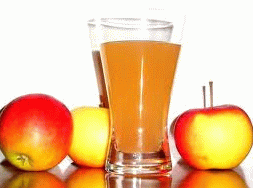
- Back in Soviet times, the questions of young mummies, when and how much juice a child can be given, pediatricians unequivocally answered that juices can be included in the children's diet from the five weeks of the baby’s life, starting with a few drops.
- According to the current recommendations of the Institute of Nutrition of the Russian Academy of Medical Sciences and SanPinov for catering for children of the first year of life, the time for introducing juices into baby food has shifted significantly. The first juices are recommended to be taken in the diet not earlier than 4-5 months from birth, starting with 5 ml.
- Some domestic and foreign doctors, and modern parents argue that with the use of juices in baby food you need to be very careful. They note that it is best to give juices to a child after the introduction of all the main complementary foods, such as cereals, vegetables, meat, fish, etc. Early introduction of juices is fraught with gastrointestinal diseases, frequent allergic conditions, and metabolic disorders in the body.
Rules for the introduction of juices in the children's menu - how to properly, how much and what juices to give a child?
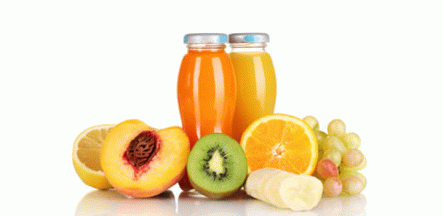
- It is better to give juice after feeding. In this case, it is an additional source of nutrition, as it should be at this age;
- Drinking juices before or between feeds can reduce the baby’s appetite and provoke a “rejection of the breast” due to the fact that the juice of the baby seems “tastier”;
- You can give juice from a teaspoon or a bottle with a dummy; for older kids, you can use special drinkers;
- Juices from the store can be given undiluted. Juices cooked at home, it is better to dilute with water in a ratio of 1 to 1.
- To calculate how much ml of juice to give a child of a specific age per day, use the formula: n * 10ml. (n is the baby's age (month));
- What juices to give to a child are also defined in the recommendations of the Institute of Nutrition of the Russian Academy of Medical Sciences and SanPinakh. The first juices with which to introduce the baby are apple or pear without adding other fruits;
- It is better if the first juice is clarified, and after a while it can be offered with pulp;
- Vegetable juices are recommended: carrot, cabbage. Their fruit: currant, cherry, apricot, pomegranate;
- It is not recommended for children under one year to give orange, lemon, grapefruit, pineapple juice. You should also be careful with the grape, it causes increased gas formation in the baby.
If your child
Juices are very useful for the child, as they contain vitamins and organic acids. They have a positive effect on the digestion and the functioning of the body as a whole. Some pediatricians recommend introducing complementary foods with juices as early as 4-5 months, but modern experts advise not to rush to give drinks to babies for up to six months. In this article we will analyze in detail how many months you can give juices to infants. We will also find out what drinks and from what age they give babies.
When and how to give juice to infants
The first baby food begins from six months with vegetable and fruit purees, and only then after the seventh month they give juices. Remember that it is impossible feed newborns juices, in exceptional cases, you can give drinking water! If the child is on artificial or mixed feeding, lure start with 3-4 months. So, drinks from fruits, vegetables and berries can be given early, already from 4-5 months.
Juices begin to drink from 5 ml (¼-⅓ tsp), then the dosage is gradually increased to 30 ml, each time adding 5 ml. The rate for one year old baby is 50-60 ml. Water the child with a teaspoon, older children can be taught to the cup.
Carefully monitor the state of infants, it is important that the drink does not cause a negative reaction. Some fruits and vegetables can provoke a rash and itching of the skin, interfere with digestion and cause stomach upset, worsen the stool. If you notice food allergy symptoms , temporarily exclude the product from the baby’s food and contact your pediatrician. It is possible to repeat the injection no earlier than in 4-5 weeks.
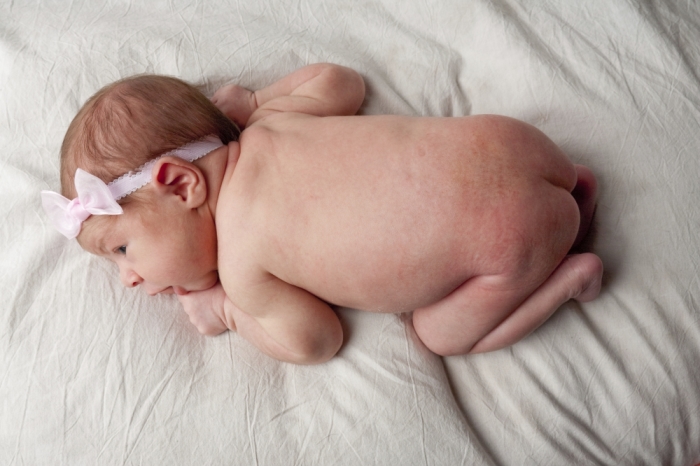
The correct lure will protect the child from the negative reaction and will bring only benefit. Fruit, vegetable and berry juices have the following useful functions:
- Strengthen the immune system;
- Saturate the body with vitamins, minerals and beneficial acids;
- Cheer up, give cheerfulness and strength;
- Improves digestion;
- They cleanse the body, remove excess salts, toxins and other harmful substances;
- Establish metabolism;
- Simplify digestion and assimilation of food;
- Increase appetite;
- Positively affect the functioning of the heart and blood vessels.
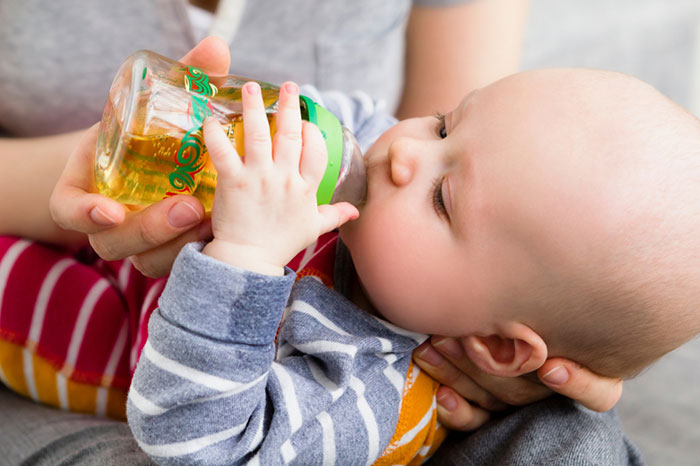
What juices can baby
At first, give juices from only one component. Bicomponent drinks are given only after each ingredient is individually administered. You can buy ready-made children's juice. Before buying, check the expiration date and composition, package integrity. The product must meet the age of the child!
However, experts recommend preparing fresh juices for babies, as fresh juice is more useful and natural. Purchased drinks can not be diluted, and cooked at home is first diluted by half with water. Gradually reduce the amount of water, replacing natural juice. Now let's consider the order of introduction of juices.
- Apple juice is given in the first place, starting with seven months. Take green varieties for cooking, as they are less likely to cause allergies;
- A week after the apple pear juice is injected. Pears are very useful and also the least allergenic among fruits;
- Apricot or peach give after pears and apples. These fruits have a positive effect on vision, strengthen bones, teeth and gums;
- Among vegetable juices in the first place include carrots and fresh carrot for infants. But be careful, because of beta-carotene and orange color, carrots can cause allergies;
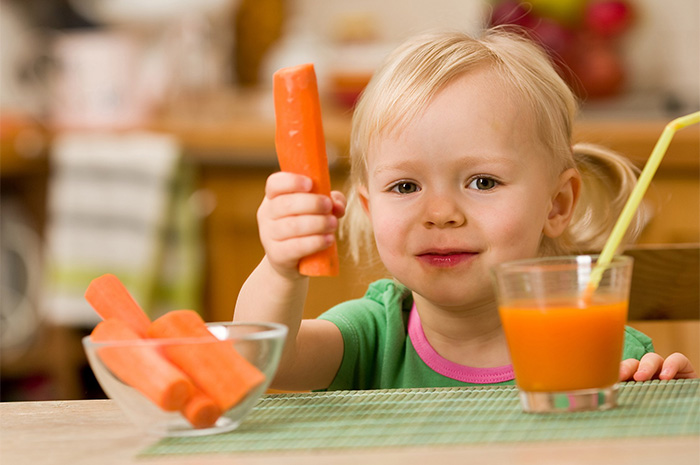
- Then they give pumpkin fresh, cabbage, cherry and plum, currant and pomegranate, banana with an interval of 3-7 days, depending on the characteristics of the development and addiction of the baby to the new food;
- Do not rush to give beet juice, as the beets are well weakened. Beetroot drink is not recommended for children under eight months and babies who suffer from diarrhea. But with constipation such a drink would be an excellent tool;
- After nine months, give two component juices. An excellent option would be a combination of apple, pumpkin, apricot or peach, banana.
Children under one year old should not be given citrus juices, including oranges, lemons, pineapples, grapes and other similar fruits. In addition, you should not drink drinks from berries of bright color, including strawberries and raspberries. Such products increase gas formation, negatively affect digestion and the state of the stomach, and often cause an allergic reaction.
Preparation of juices about the same. Vegetable or fruit is peeled, cut into slices or pieces and passed through a juicer. Then drink filtered and diluted with boiled drinking water. Giving juices with pulp and adding sugar to the drink to children under one year is not recommended.
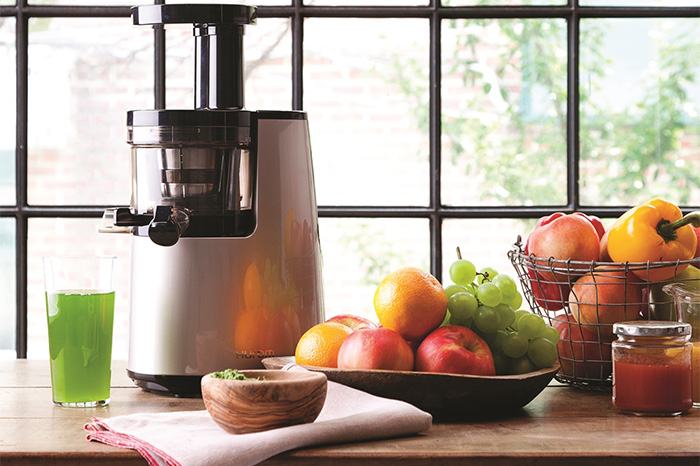
Compotes should be given along with juices. Such drinks are assimilated and perceived more easily than saturated fresh juices. Especially useful compote of dried fruit. This drink can be entered from 6-7 months, then give drinks from fresh berries and fruits. How to make compote for babies, see.